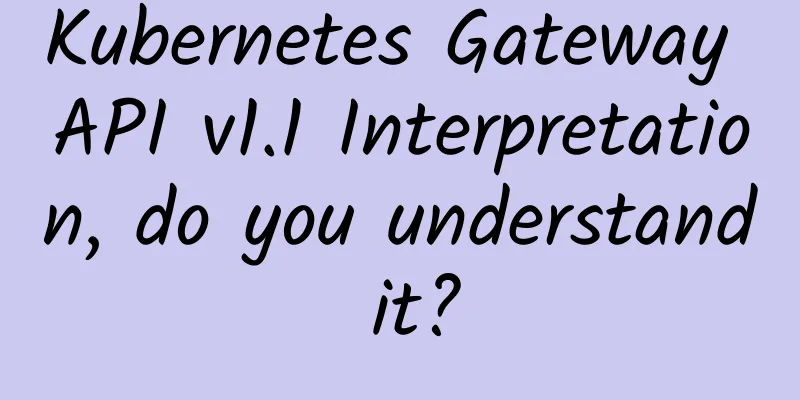Kubernetes Gateway API v1.1 Interpretation, do you understand it?

|
A few days ago, the K8s Network SIG released the Gateway API (gwapi) v1.1[1]. This version includes the GA (general availability) of many important features, as well as the introduction of some experimental features. These two parts were released through the standard channel and experimental channel respectively. Release channels are used to indicate the stability of features within the Gateway API. All new features and resources start in the experimental release channel and may be promoted to the standard release channel or completely deprecated from the API during subsequent iterations. The following figure gives you a clear understanding of gwapi's release channels. picture Among these updates, the most important one in my opinion is the GA support for service mesh, which means that the service mesh standard API has taken another step towards unification. Almost two years ago, I wrote about what the SMI and the GAMMA initiative for the Gateway API meant. When gwapi was almost 1.0, SMI was archived after a few months of stopping updates. Standard release channelsGRP Route GAThe release of GRPCRoute API v1 indicates that it can be used stably in production environments and will be supported and maintained for a long time. At the same time, v1alpha2 is marked as deprecated and will be removed in future versions. Service Mesh Support GAgwapi has officially graduated its support for service mesh and entered the standard release channel. After implementing support for the mesh, the same API can be used to manage east-west (inter-service) traffic, so policies built on gwapi can be reused in the mesh. If you are interested, you can read last year's article Exploring the working mechanism of the Gateway API in Service Mesh, or refer to the official documentation [2]. Starting from v1.1, xRoute can attach to (parent resource) Gateway and Service. Specifically, parentRef.kind can be Gateway (default) and Service. For example: HTTPRoute for Gateway: Omit kind: Gateway. HTTPRoute for service mesh: Profiles and reports for consistency checks GAThe Conformance Reporting API and corresponding test suite have been upgraded to GA v1. About the Conformance Report: A compliant implementation of the Gateway API specification is one that passes the conformance tests included in each gwapi bundle version release (e.g. gateway.networking.k8s.io/bundle-version: v1.1.0). All gwapi implementations must pass the conformance tests and may not skip any of the tests. In version v1, the ConformanceReport API extends the two fields mode and gatewayAPIChannel. The former is used to specify the working mode of the implementation, and the latter identifies the release channel applicable to the report: standard release or experimental release. Reports have also been reorganized in a more structured way, and implementations can now add information about how the tests were run and provide steps to reproduce the results. ParentRef's Port field GAPreviously, when multiple listeners were configured on a Gateway, if you wanted to attach a route to a specific port, You can use sectionName to specify the name of the listener, so you need to set a name for the listener using the name field. This can now be done using the port field, which is also unique on the gateway, eliminating the need to use the name field. Experimental Release ChannelSupport session persistence through BackendLBPolicyIntroduced session persistence support via BackendLBPolicy, a feature from the Gateway Enhancement Proposal GEP-1619[3]. Session persistence means that client requests are directed to the same backend server for the duration of a "session". When the client directly provides information (such as a cookie in a request header), the proxy uses it as a reference to direct traffic to a specific server. Persistence is an exception to load balancing: persistent client requests bypass the proxy's load balancing algorithm and go directly to the backend server with which the session was previously established. See the official definition of session persistence [4]. The session persistence of gwapi can be applied to the service granularity or to a single route. The latter has a higher priority and will override the session persistence configuration at the service granularity. Session persistence at the route granularity is configured via sessionPersistence in the route rule. Service-level session persistence is configured via BackendLBPolicy. Note: The type in the core API is Cookie, and the implementation can be extended to support any request header, the type is Header. Client certificate verificationThe Gateway Enhancement Proposal GEP-91[5] discusses how to verify the TLS certificate provided by the front-end client to the server during the TLS handshake protocol, which can be regarded as client authentication in mTLS. In the official core API design, the CA certificate in the ConfigMap specified by the listener's tls.frontendValidation is used to authenticate the client. The core API only supports one ConfigMap, and the implementation is extensible to support multiple ConfigMaps or other types such as Service. BackendTLSPolicyBackendTLSPolicy[6] is a type in gwapi that specifies the TLS configuration for connections from the gateway to the backend Pod (or multiple Pods) through the Service API object. It is the opposite of client authentication and is an authentication of the backend service. There are two types of authentication for backend services:
picture Compared with v1alpha2 in v1.0, the major changes in v1alpha3 in v1.1 are:
Gateway parametersDifferent gwapi implementations use different load balancers, such as Envoy Gateway uses Envoy, and FSM Gateway uses Pipy. Different load balancers have different configurations, and gwapi cannot provide a common interface. Therefore, a configuration interface is provided on the GatewayClass API through the spec.parametersRef field. However, the configuration of GatewayClass is global and applies to all Gateway instances. It cannot be configured for a specific Gateway instance, which makes it difficult to meet the needs. Then there is the Gateway Enhancement Proposal GEP-1867[7]. In a similar way to GatewayClass, the Gateway API in this proposal configures `LocalParametersReference`[8] through the infrastructure.parametersRef field, which is defined by each gwapi implementation. Other updatesIn addition to the functions of the two release channels, there are other updates that will not be introduced one by one.
The get command is extended to support gateways, gatewayclasses, and namespaces. The describe command now supports describing policycrds and namespaces. Added ability to filter resources using tags (via -l option). Fixed an error that was not described when describing gatewayclasses.
For more information, please refer to the v1.1.0 update notes[9]. References[1] v1.1 version: https://github.com/kubernetes-sigs/gateway-api/releases/tag/v1.1.0 [2] Official documentation: https://gateway-api.sigs.k8s.io/mesh/ [3] Gateway Enhancement Proposal GEP-1619: https://gateway-api.sigs.k8s.io/geps/gep-1619 [4] Session persistence definition: https://gateway-api.sigs.k8s.io/geps/gep-1619/?h=backendlbpolicy#defining-session-persistence [5] Gateway Enhancement Proposal GEP-91: https://gateway-api.sigs.k8s.io/geps/gep-91/ [6] BackendTLSPolicy: https://gateway-api.sigs.k8s.io/api-types/backendtlspolicy [7] Gateway Enhancement Proposal GEP-1867: https://gateway-api.sigs.k8s.io/geps/gep-1867 [8] LocalParametersReference: https://gateway-api.sigs.k8s.io/reference/spec/#gateway.networking.k8s.io/v1.LocalParametersReference [9] v1.1.0 update notes: https://github.com/kubernetes-sigs/gateway-api/releases/tag/v1.1.0 |
<<: Real-time advertising recommendation system implemented by SpringBoot and Apache Doris
>>: Ether color light empowers the implementation of smart campus construction standards
Recommend
Interviewer: Tell me what happens after you enter the URL in the address bar and press Enter?
[[401931]] This article is reprinted from the WeC...
Private 5G is key to improving safety, efficiency and productivity in the mining industry
Mining is one of the most important industries in...
How to Choose an Ethernet Cable
In most cases, choosing an Ethernet cable is rela...
China 6G: The next technological frontier!
China is promoting the application of informatiza...
A brief discussion on the integrated development of data centers
In the tide of information and communication tech...
Five IoT trends that we need to pay attention to in 2018!
The Internet of Things has become a globally reco...
Network Slicing "Hot Pot Theory": Same Pot, Different Dreams
In the dog days of summer, when people are "...
WiFi is getting slower and slower. Here’s how to revive it
Using WiFi to surf the Internet has become an ind...
You want to ask me about the application layer? I'll just talk to you about it.
Network applications are the reason for the exist...
The Importance of Switchgear to Data Center Uptime
Among all the electrical and system components th...
SaltyfishTech: San Jose CN2 GIA line VPS quarterly payment starting from $15.9, 1GB/10G SSD/1TB@300Mbps
SaltyfishTech recently offered a 7.8 discount cod...
LOCVPS limited special offer 2GB package starting from 252 yuan/year, Hong Kong (Kwai Wan/Tai Po/Yundi)/Singapore data center
LOCVPS (Global Cloud) is a long-established Chine...
Are you a left-brained or right-brained person? (Test included)
【51CTO.com Quick Translation】 The success of a co...
Network programming - starting from establishing a TCP connection
[[388071]] Preface Network programming is somethi...




![[Black Friday] CloudCone: Los Angeles VPS from $16.79/year, Premium SC2 from $32.94/year](/upload/images/67cabff9214b9.webp)




